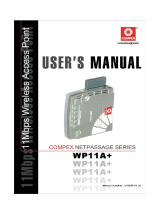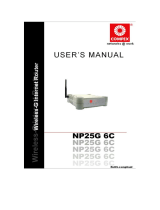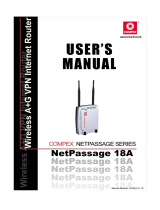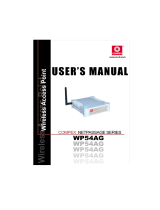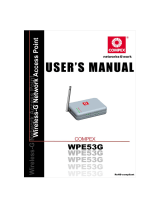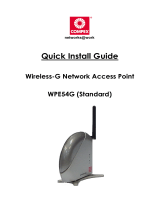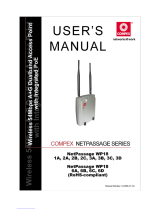Page is loading ...


i
© Copyright 2007 Compex Systems Pte Ltd
All Rights Reserved
This document contains information, which is protected by copyright. Reproduction, adaptation
or translation without prior permission is prohibited, except as allowed under the copyright
laws.
Trademark Information
Compex
®
is a registered trademark of Compex, Inc. Microsoft Windows and the Windows logo
are the trademarks of Microsoft Corp. NetWare is the registered trademark of Novell Inc. All
other brand and product names are trademarks or registered trademarks of their respective
owners.
Notice: Copyrights © 2007 by Compex, Inc. All rights reserved. Reproduction, adaptation, or
translation without prior permission of Compex, Inc. is prohibited, except as allowed under the
copyright laws.
Manual Revision by Daniel
Manual Number: U-0428-V1.4C Version 1.4, May 2007
Disclaimer
Compex, Inc. provides this manual without warranty of any kind, expressed or implied,
including but not limited to the implied warranties of merchantability and fitness for a particular
purpose. Compex, Inc. may make improvements and/or changes to the product and/or
specifications of the product described in this manual, without prior notice. Compex, Inc will
not be liable for any technical inaccuracies or typographical errors found in this guide. Changes
are periodically made to the information contained herein and will be incorporated into later
versions of the manual. The information contained is subject to change without prior notice.
Your Feedback
We value your feedback. If you find any errors in this user’s manual, or if you have suggestions
on improving, we would like to hear from you. Please contact us at:
Fax: (65) 62809947
Email: [email protected]

ii
FCC NOTICE
This device has been tested and found to comply with the limits for a Class B digital device,
pursuant to Part 15 of the FCC Rules. These limits are designed to provide reasonable
protection against harmful interference in a residential installation. This device generates, uses
and can radiate radio frequency energy and, if not installed and used in accordance with the
instructions, may cause harmful interference to radio communications. However, there is no
guarantee that interference will not occur in a particular installation. If this device does cause
harmful interference to radio or television reception, the user is encouraged to try to correct the
interference by one or more of the following measures:
• Reorient or relocate the receiving antenna.
• Connect the computer into an outlet on a circuit different from that to which the receiver is
connected.
• Increase the separation between the computer and receiver.
• Consult the dealer or an experienced radio/TV technician for help.
Caution: Any changes or modifications not expressly approved by the grantee of this device
could void the user's authority to operate the equipment.
FCC Compliance Statement: This device complies with Part 15 of the FCC Rules. Operation
is subject to the following two conditions:
1. This device may not cause harmful interference, and
2. This device must accept any interference received, including interference that may cause
undesired operation.
This device must accept any interference received, including interference that may cause
undesired operation.
Products that contain a radio transmitter are labelled with FCC ID and may also carry the FCC
logo.
Caution: Exposure to Radio Frequency Radiation.
To comply with the FCC RF exposure compliance requirements, the following antenna
installation and device operating configurations must be satisfied:
a. For configurations using the integral antenna, the separation distance between the antenna(s)
and any person’s body (including hands, wrists, feet and ankles) must be at least 2.5cm (1
inch).
b. For configurations using an approved external antenna, the separation distance between the
antenna and any person’s body (including hands, wrists, feet and ankles) must be at least
20cm (8 inch).
The transmitter shall not be collocated with other transmitters or antennas.

iii
ICES 003 Statement
This Class B digital apparatus complies with Canadian ICES-003.
Declaration of Conformity
Compex, Inc. declares the following:
Product Name: Compex Wireless Dual-Band Network Access Point
Model No.: Compex WPE54 conforms to the following Product Standards:
Radiated Emission Standards:
ETSI EN 300 328-2: July 2000; FCC: 47 CFR Part 15, Subpart B, ANSI C63.4-1992; 47 CFR
Part 15, Subpart C (Section 15.247), ANSI C63.4-1992.
Conducted Emission Standards:
ETS 300 826: Nov. 1997.
Immunity Standards:
IEC 801-2; IEC 801-3; IEC 801-4
Low Voltage Directive:
EN 60 950:1992+A1: 1993+A2: 1993+A3; 1995+A4; 1996+A11: 1997
Therefore, this product is in conformity with the following regional standards: FCC Class B
⎯ following the provisions of FCC Part 15 directive; CE Mark ⎯ following the provisions of
the EC directive.
This Class B digital apparatus complies with Canadian ICES-003.

iv
Technical Support Information
The warranty information and registration form are found in the Quick Install Guide.
For technical support, you may contact Compex or its subsidiaries. For your convenience, you
may also seek technical assistance from the local distributor, or from the authorized
dealer/reseller that you have purchased this product from. For technical support by email, write
to
Refer to the table below for the nearest Technical Support Centres:
Technical Support Centres
Contact the technical support centre that services your location.
U.S.A., Canada, Latin America and South America
Write
Compex, Inc.
840 Columbia Street, Suite B
Brea, CA 92821, USA
Call
Fax
Tel:
Tel:
Fax:
+1 (714) 482-0333 (8 a.m.-5 p.m. Pacific time)
+1 (800) 279-8891 (Ext.122 Technical Support)
+1 (714) 482-0332
Asia, Australia, New Zealand, Middle East and the rest of the World
Write
Compex Systems Pte Ltd
135, Joo Seng Road #08-01, PM Industrial Building
Singapore 368363
Call
Tel:
Tel:
Fax:
(65) 6286-1805 (8 a.m.-5 p.m. local time)
(65) 6286-2086 (Ext.199 Technical Support)
(65) 6283-8337
Internet access/
E-mail:
FTPsite:
ftp.compex.com.sg
Website:
http://www.cpx.com or http://www.compex.com.sg
Fax

v
About This Document
The product described in this document, Compex Wireless Dual-Band Network Access Point,
Compex WPE54 is a licensed product of Compex Systems Pte Ltd. This document contains
instructions for installing, configuring and using Compex WPE54. It also gives an overview of
the key applications and the networking concepts with respect to the product.
This documentation is for both Network Administrators and the end user who possesses some
basic knowledge in the networking structure and protocols.
It makes a few assumptions that the host computer has already been installed with TCP/IP and
already up & running and accessing the Internet. Procedures for Windows 98SE/ME/2000/XP
operating systems are included in this document. However, for other operating system, you may
need to refer to your operating system’s documentation for networking.
How to Use this Document
This document may become superseded, in which case you may find its latest version at:
http://www.compex.com.sg
The document is written in such a way that you as a user will find it convenient to find specific
information pertaining to the product. It comprises of chapters that explain in details on the
installation and configuration of Compex WPE54.
Firmware
This manual is written based on Firmware version 2.09
Conventions
In this document, special conventions are used to help and present the information clearly. The
Compex Wireless Dual-Band Network Access Point is often referred to as Compex WPE54 in
this document. Below is a list of conventions used throughout.
NOTE
This section will consist of important features or instructions
CAUTION
This section concerns risk of injury, system damage or loss of data
WARNING
This section concerns risk of severe injury
References on Menu Command, Push Button, Radio Button, LED and Label appear in Bold.
For example, “Click on Ok.”

vi
Copyrights © 2007 Compex Systems Pte Ltd..................................................................................i
Trademark Information.....................................................................................................................i
Disclaimer ........................................................................................................................................i
Your Feedback..................................................................................................................................i
FCC NOTICE..................................................................................................................................ii
Declaration of Conformity...............................................................................................................ii
Technical Support Information...................................................................................................... iii
About This Document ....................................................................................................................iv
How to Use this Document.............................................................................................................iv
Firmware………..……….……………….………………………………………………………iv
Conventions....................................................................................................................................iv
Chapter 1 Product Overview...................................................................................... 9
1.1 Introduction............................................................................................................................9
1.2 Features and Benefits.............................................................................................................9
1.3 When to use which mode.....................................................................................................11
1.3.1 The Access Point Mode...........................................................................................12
1.3.2 The Access Point Client Mode.................................................................................13
1.3.3 The Gateway Mode..................................................................................................14
1.3.4 The Wireless Routing Client Mode .........................................................................16
1.3.5 The Wireless Ethernet Adapter Mode......................................................................17
1.3.6 The Wireless Bridge Link Mode..............................................................................17
Chapter 2 Hardware Installation.............................................................................. 18
2.1 Setup Requirements .............................................................................................................18
2.2 Hardware Installation...........................................................................................................19
Chapter 3 Access to Web-based Interface ............................................................... 20
3.1 Access to the Web interface with uConfig...........................................................................20
3.2 Direct access to web-based interface via Internet Explorer..................................................23
Chapter 4 Common Configuration........................................................................... 27
4.1 Management Port Setup.......................................................................................................27
4.1.1 To view the active DHCP leases..............................................................................30
4.1.2 To reserve specific IP addresses for predetermined DHCP clients..........................31
4.2 WLAN Setup........................................................................................................................34
4.2.1 To configure the Basic setup of the wireless mode..................................................35
4.2.2 To configure the Advanced setup of the wireless mode...........................................38
4.3 Scan for Site Survey.............................................................................................................41
4.3.1 Show Link Information............................................................................................43

vii
4.4 Wireless Extended Features .................................................................................................44
4.4.1 Access Control – The Wireless Pseudo VLAN........................................................44
4.4.2 Wireless Setup - The Wireless Distributed System (WDS) .....................................52
4.4.3 WMM Parameters....................................................................................................58
4.4.4 Long Distance Parameters.......................................................................................61
4.5 WLAN Security ...................................................................................................................63
4.5.1 How to set up WEP..................................................................................................64
4.5.2 How to set up WPA-PSK.........................................................................................66
4.5.3 How to set up 802.1x/RADIUS ...............................................................................68
4.5.4 How to set up WPA EAP.........................................................................................69
4.6 STP Setup.............................................................................................................................71
4.7 SNMP Setup.........................................................................................................................79
4.8 MAC Filtering......................................................................................................................79
Chapter 5 Further Configuration.............................................................................. 81
5.1 Setting up uConfig ...............................................................................................................81
5.2 Configuring WAN Setup......................................................................................................82
5.2.1 Dynamic IP..............................................................................................................83
5.2.2 Static IP ...................................................................................................................84
5.2.3 PPPoE......................................................................................................................85
5.2.4 Singapore ADSL......................................................................................................87
5.2.5 Australia BPA Cable................................................................................................88
5.2.6 PPTP........................................................................................................................89
5.3 Using NAT...........................................................................................................................90
5.3.1 To set up a De-Militarised Zone host.......................................................................91
5.3.2 To set up port forwarding ........................................................................................92
5.4 Routing 96
5.4.1 Static Routing..........................................................................................................97
5.4.2 Dynamic Routing.....................................................................................................98
5.5 Implementing IP Filtering ....................................................................................................99
5.6 Applying Remote Management..........................................................................................104
5.7 Enabling Parallel Broadband..............................................................................................105
5.7.1 Load balancing.......................................................................................................105
5.7.2 Fail-Over Redundancy...........................................................................................106
5.7.3 To enable Parallel Broadband................................................................................107
Chapter 6 System Utilities ..................................................................................... 108
6.1 Using the SYSTEM TOOLS Menu....................................................................................108
6.1.1 System Identity......................................................................................................108
6.1.2 WLAN Station List................................................................................................109
6.1.3 Set System’s Clock................................................................................................110
6.1.4 Firmware Upgrade.................................................................................................111
6.1.5 Save or Reset Settings............................................................................................112

viii
6.1.6 Reboot System.......................................................................................................113
6.1.7 Change Password...................................................................................................114
6.1.8 Logout....................................................................................................................115
6.2 Using the HELP menu........................................................................................................116
6.2.1 Get Technical Support...........................................................................................116
6.2.2 About System ........................................................................................................117
Appendix I Troubleshooting..................................................................................... 118
AI Solutions to Common Problems.........................................................................................118
Appendix II Firmware Recovery............................................................................... 122
AII How to recover the access point from failed firmware.......................................................122
Appendix III TCP/IP Configuration............................................................................ 123
AIII.1 Configure dynamic IP Address in Windows 98SE/ME...................................................123
AIII.2 Configure dynamic IP Address in Windows XP/2000....................................................127
AIII.3 Configure static IP Address in Windows 98SE/ME........................................................129
AIII.4 Configure static IP Address in Windows XP/2000 .........................................................130
Appendix IV Panel Views and Descriptions............................................................... 131
Appendix V Technical Specifications................................................................... cxxxiii

Chapter 2 Hardware Installation
9
Chapter 1 Product Overview
1.1 Introduction
The 54Mbps wireless access point is a compact and high performance access point that
is designed with support for high security features like WPA, IEEE 802.1x
Authentication and 64-bit or 128-bit Wired Equivalent Privacy. The exclusive wireless
LAN technology Wireless Pseudo VLAN further enhances security in wireless hotspot
networks in isolating different users into their own VLANs. The access point is capable
of operating in 5 different modes: Access Point Bridging, Access Point Client, Gateway,
Wireless Routing Client and Wireless Ethernet Adapter; making it suitable for all kinds
of wireless applications.
1.2 Features and Benefits
The access point has been designed for high performance and offers a rich suite of
features, with which you should acquaint yourself to be able to exploit the access point’s
full potential
Wireless Distribution System
This unique feature allows linking of several access points, virtually creating a
larger wireless network infrastructure that allows desktops or laptops that are
connected to the access point to share their network resources wirelessly.
Pseudo Virtual LAN
The unique Wireless Pseudo Virtual LAN technology is a feature that allows a
wireless client or groups of wireless client to be segmented wirelessly into its
individual workgroup or individual node thus enhancing the privacy of the wireless
clients. This is especially useful in public hotspot deployment.
Secured Wireless Authentication
The access point supports the latest wireless security standard—WPA. The wireless
users now enjoy the freedom of wireless roaming without worrying important data
being exposed to outsiders. WPA has two different modes: WPA-PSK for SOHO
users and WPA-EAP for Enterprise users. The access point supports WPA-EAP
using IEEE 802.1x-based Extensible Authentication Protocol (EAP) for secure and
centralized user-based authentication. The wireless clients are now able to
authentication through a RADIUS server to the authorized network through highly
secured authentication methods like EAP-TLS, EAP-TTLS, and EAP-PEAP.

Chapter 2 Hardware Installation
10
Smart Select
This feature will automatically scan and recommend the best channel that the access
point can utilize.
Wireless Routing Client Capability
The Wireless Routing Client mode enables Internet Service Provider (ISP) or offices
to send their data packet wirelessly and these network packets will be routed to a
wired Local Area Network via the access point.
Wireless Ethernet Adapter
The Wireless Ethernet Adapter mode enables any computers with an Ethernet
interface to be connected to the wireless LAN without the need to install any driver
software. This is extremely useful for machines with limited driver support, e.g.
Apple Macintosh machines and Linux machines.
Parallel Broadband
This unique feature allows bandwidth aggregation and fail-over redundancy
capability when set to gateway mode which uses wireless distribution system to
wirelessly link all associated access point gateway together.
Universal Configuration Software
The uConfig software allows users to get onto the web based configuration interface
of the access point without the need to further manipulate the TCP/IP setup of the
workstation.
Web-based Management Interface
Embedded with a HTTP server allows the configuration of the access point features
via a user-friendly web-based management interface. In addition, firmware upgrade
can be done through this interface as well.
IEEE 802.1x Authentication and WPA
The access point supports latest wireless security WPA using both Pre-Share Key
and 802.1x EAP authentication. A wide range of IEEE 802.1x authentication
methods like EAP-MD5, EAP-TLS, EAP-TTLS, and EAP-PEAP for strong mutual
authentication and data encryption is supported.
Wireless Pseudo Virtual LAN
Allows the creation of wireless virtual nodes or workgroups for wireless clients to
increase the privacy in a wireless LAN installation.
SNMP
For easy remote management and monitoring of the access point through standard
SNMP software.

Chapter 2 Hardware Installation
11
STP
Spanning-Tree Protocol provides path redundancy while preventing undesirable
loops in the network. It forces certain redundant data paths into a standby (blocked)
state. If one network segment in the Spanning-Tree Protocol becomes unreachable,
or if Spanning-Tree Protocol costs change, the spanning-tree algorithm reconfigures
the spanning-tree topology and re-establishes the link by activating the standby path.
1.3 When to use which mode
The access point is unique in the sense that it may operate in up to 5 different complex
modes in order to best suit any type of network application that you require.
This section presents a brief outline of the different network applications that can be
accommodated through the different modes of the access point.

Chapter 2 Hardware Installation
12
1.3.1 The Access Point Mode
This is the default mode of the access point. The Access Point mode enables
you to bridge wireless clients to the wired network infrastructure.

Chapter 2 Hardware Installation
13
1.3.2 The Access Point Client Mode
In Access Point Client mode, the access point acts as a wireless client that
can operate wirelessly with another access point to perform transparent
bridging between two Fast Ethernet networks.

Chapter 2 Hardware Installation
14
1.3.3 The Gateway Mode
Or more simply put: Broadband Internet sharing in a wireless network!
Since the access point supports several types of broadband connections, the
first step in setting up the access point as a Broadband Internet Gateway is to
identify the type of broadband Internet access you are subscribed to.
Static IP address
Use this type of connection if you have subscribed to a fixed IP address or to a
range of fixed IP addresses from your Internet Service Provider.
Dynamic IP address
When powered using this type of connection, the access point requests for an
IP address which will be automatically assigned to it by your Internet Service
Provider.
This type of connection applies for instance, to:
• Singapore Cable Vision subscribers
• @HOME Cable Service users

Chapter 2 Hardware Installation
15
PPP over Ethernet (PPPoE)
Select this type of connection if you are using ADSL services in a country
utilising standard PPP over Ethernet for authentication.
For instance:
If you are in Germany which uses T-1 connection or
If you are using SingNet Broadband or Pacific Internet Broadband in
Singapore:
Singapore ADSL (Ethernet 512K)
This applies to ADSL subscribers in Singapore including SingTel Magix
SuperSurf users.
Australia BPA Cable
This connection type is customised for Big Pond Cable Internet users in
Australia.
PPTP
The Point-to-Point Tunneling Protocol (PPTP) mode enables the
implementation of secure multi-protocol Virtual Private Networks (VPNs)
through public networks.

Chapter 2 Hardware Installation
16
1.3.4 The Wireless Routing Client Mode
An application of this mode would be for the Ethernet port of the Wireless
Routing Client to be used for connection with other devices on the network
while access to the Internet would be achieved through wireless
communication with wireless ISP.

Chapter 2 Hardware Installation
17
1.3.5 The Wireless Ethernet Adapter Mode
Similarly to the Access Point Client mode, the access point used in this mode,
is able to communicate wirelessly with another access point to perform
transparent bridging between two networks.
However here, the Wireless Ethernet Adapter connects a single wired
workstation only. No client software or drivers are required while using this
mode.
1.3.6 The Wireless Bridge Link Mode
The Wireless Bridge Link mode allows point-to-point communication
between different buildings. It enables you to bridge wireless clients that are
kilometres apart ( eg. within 100 metres between two buildings ) while
unifying the networks. In this scenario, you may configure two of the access
point units to perform transparent bridging between two buildings.

Chapter 2 Hardware Installation
18
Chapter 2 Hardware Installation
2.1 Setup Requirements
Before starting, please verify that the following is available:
CAT5/5e networking cable
At least one computer is installed with a Web browser and a wired or wireless network
interface adapter
TCP/IP protocol is installed and IP address parameters are properly configured on all
your network’s nodes

Chapter 2 Hardware Installation
19
2.2 Hardware Installation
In three simple steps, you may power ON and begin configuring the access point.
Use the RJ45 cable to connect the Ethernet port of the access point to your PC.
Once you have finished configuring the access point, you can connect the Ethernet
cable to your network device, such as to a switch or hub.
Next, attach the power adapter supplied in the packaging to the main power supply and
connect its power plug into the DC jack of the access point.
Power ON your PC. Notice that the Power and LAN LEDs of the access point have
lighted up. This indicates that the connection has been established successfully
between the AP and your PC.
/
